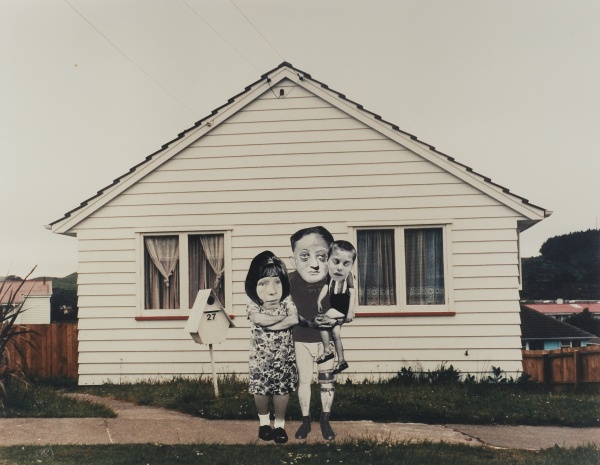ARTISTS Mladen Bizumic, Derrick Cherrie, Margaret Dawson, Bill Hammond, Michael Harrison, Gavin Hipkins, Dylan Horrocks, Saskia Leek, Lauren Lysaght, Andrew McLeod, Anne Noble, Ani O'Neill, Fiona Pardington, Michael Parekōwhai, John Pule, Richard Reddaway, Peter Robinson, Ava Seymour, Marie Shannon, Michael Shepherd, Michael Stevenson, Peter Stichbury, Yuk King Tan, Yvonne Todd, Ronnie van Hout, John Walsh, Ruth Watson, Boyd Webb, Brendon Wilkinson CURATORS Emma Budgen, Gregory O'Brien, Natasha Conland SPONSOR Simpson Grierson
Since opening in 1998, Te Papa has been criticised for its treatment of art. Small World, Big Town showcases works from its art collection, outside its building, but nearby—at City Gallery. In the Listener, Aaron Kriesler asks:‘when the idea for this exhibition was mooted, did everybody involved think that this would absolve the discontent and produce a blockbuster? Was this to be one of those elusive win-wins?’
The title sets out to indicate an ideological shift: recoiling from a preoccupation with nationhood, a new generation of New Zealand artists are embracing individual experience and their place in a wider, shrinking world. The show is split into three sections: ‘Highway to Hicksville’ (curated by City Gallery's Emma Budgen), ‘Little People’ (curated by Te Papa's Natasha Conland), and ‘Outer Limits’ (curated by City Gallery's Gregory O'Brien).
The lifestyle block embodies the middle-class urge to ‘get away from it all’. Budgen writes, ‘Hicksville is back in vogue’. The works in this section ‘sidestep any attempt to flag bear for the nation by simply focusing on interesting diversions close at hand’. Michael Stevenson’s This Is the Trekka was New Zealand's contribution to the 2003 Venice Biennale. The project investigates New Zealand’s ‘indigenous’ car, produced in the 1960s and 1970s—designed for the national imagination as much as for rural off-roading. Ava Seymour’s House at Cannon’s Creek (1997) is toxic, making fun of our welfare-state suburban ideals. Other works—Saskia Leek’s zero-gravity skyscapes and Bill Hammond’s hybrid bird-people—are more fantastical. Dylan Horrocks’s 2001 graphic novel Hicksville represents a mythical district where sheep farmers and fishermen passionately discuss obscure comic books. (Horrocks also designs the exhibition typeface and signage. According Kriesler in the Listener, this ‘coats the whole visitor experience with a tongue-in-cheek “aren't we quirky” quality’.)
‘Little People’ explores scale shifts. Conland says, ‘These are works which expand the subject but don’t overawe it.’ Reality is domesticated by Marie Shannon and Lauren Lysaght, who recreate the world in miniature. The central figure in Shannon’s King for a Day (1991) is made of pipe cleaners. Lysaght’s crafty Joseph Cornell–inspired boxes investigate the life of her transsexual ancestor, Eugenia Falleni, who lived in nineteenth-century Italy. By contrast, the magnified chess pieces of Michael Parekōwhai’s Folie à deux (1994) make the viewer seem small, while alluding to biculturalism.
O’Brien says ‘the world has grown a whole lot bigger the smaller it has become’. In ‘Outer Limits’, artists reflect on migration—identity and flux. John Pule—with his Nuian heritage—is represented with Burn My Head in Heaven 1–5 (1998), illustrated poems that relate collective and personal experiences. John Walsh's painting Hine-tītama Becomes Hine-nui-te-pō (2002) concerns the Māori goddess of death. The narrative is intentionally obscure, with a shoreline is overcome by a vast white void of cloud. Ani O’Neill’s Star by Night (1994) is a woven star pattern. Of Rarotongan heritage, O’Neill says ‘it’s about our ancestors’ dark nights of journeying by vaka, travelling with the stars and guides to Aotearoa—a dark, awe-inspiring journey … [it] relates to what has come before, and to what the future holds.’ For her Island Portrait (2004), Yuk King Tan stages a group portrait of sixty-one members of the Chinese Civil Engineering Corporation at the edge of Rarotonga’s Avarua beach. The sitters were brought to the island’s capital to construct its court house—a symbol of nationhood. With small scale and minimum production, Tan gently alludes to the impact of global economies upon cultural exchange in the twenty-first century.








































